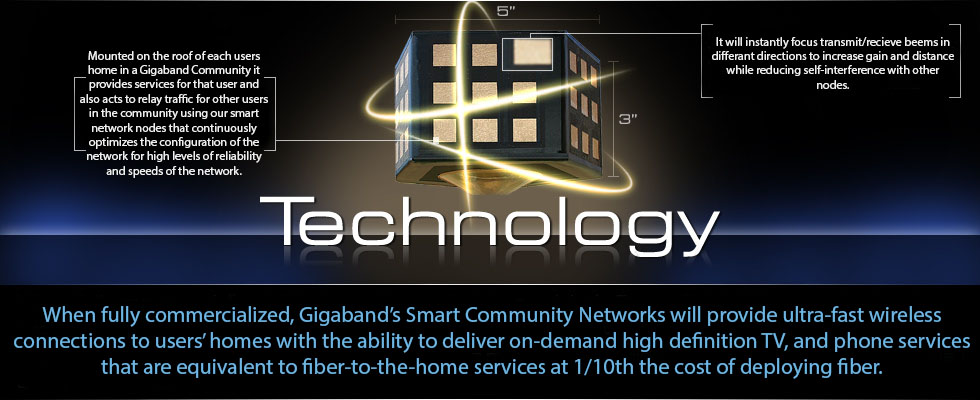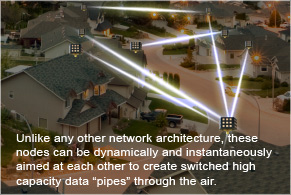
Intellectual Property and Patent Information
The power of Gigaband's intellectual property lies in the knowledge of how to optimize switched networks using distributed network management artificial intelligence build in to user nodes and central Network Optimizing Servers (NOS) in each community. This intelligence deterministically and dynamically creates high capacity switched air-circuits by aiming pre-determined pairs of high-gain electronically steerable directional antennas at each other moment-to-moment to form a grid of separate connections through the air. Basic steerable antenna technology itself is not new, having been developed by the US military during World War II. However the idea of linking the aiming of an antenna to the router tables in user nodes and intelligently coordinating the behavior of many such antennas to improve overall network performance and reliability is both novel and non-obvious.
The power of Gigaband's intellectual property lies in the knowledge of how to optimize switched networks using distributed network management artificial intelligence build in to user nodes and central Network Optimizing Servers (NOS) in each community. This intelligence deterministically and dynamically creates high capacity switched air-circuits by aiming pre-determined pairs of high-gain electronically steerable directional antennas at each other moment-to-moment to form a grid of separate connections through the air. Basic steerable antenna technology itself is not new, having been developed by the US military during World War II. However the idea of linking the aiming of an antenna to the router tables in user nodes and intelligently coordinating the behavior of many such antennas to improve overall network performance and reliability is both novel and non-obvious.
 Patent Information
Patent InformationA patent application with broad claims covering the companyís fundamental methods and architecture has been granted by the US Patent Office and equivalent patents have been granted by five other countries.

GGigaband is creating a patented, proprietary network architecture and technology based on low cost commodity radio technology that eliminates virtually all of the problems experienced with the earlier wireless bandwidth distribution attempts that have been based on either PMP or mesh network architectures. It should be noted however; that the Gigaband's technology is agnostic with regard to the type of radio-technology used and can work with radios designed for use with either licensed or free unlicensed spectrum. It is Gigaband's Intelligent Cognitive Mesh (smart) Architecture coupled with sophisticated smart antenna technology, and not improved radio technology that will produce the high levels of service reliability, availability, and bandwidth density that the industry and consumers seek. Gigaband will always integrate the most advanced radio technology available that has obtained commodity-pricing status with its proprietary network technologies.
 Each node in a Gigaband neighborhood network incorporates a low cost electronically controlled steerable eight-sided multi-mode MIMO Beam antenna array using both linearly circularly polarized antenna elements. These MIMO-Beam antenna arrays are attached to that nodes with embedded 802.11ac commodity radio chips. Unlike any other network architectures, these nodes can be dynamically and instantaneously aimed at each other to create switched-path high capacity data pipes through the air. Because high gain steerable MIMO antennas support both ends of each Gigaband connection, the typical link-gain between any two communicating nodes is 20 db. Twenty decibels of link-gain between a pair of radios means that the signal strength between a given pair of radios will be of such quality that a pair of radios located at up to 2 miles apart from one another can transfer as much data as if the radios were 10 feet apart. And, they can do this without increasing the transmit power of the radios. Using the newest 802.11ac WiFi chips, typical throughput between a pair of communicating nodes is expected to be 200 Mbps with an upper limit of 400 Mbps.
Each node in a Gigaband neighborhood network incorporates a low cost electronically controlled steerable eight-sided multi-mode MIMO Beam antenna array using both linearly circularly polarized antenna elements. These MIMO-Beam antenna arrays are attached to that nodes with embedded 802.11ac commodity radio chips. Unlike any other network architectures, these nodes can be dynamically and instantaneously aimed at each other to create switched-path high capacity data pipes through the air. Because high gain steerable MIMO antennas support both ends of each Gigaband connection, the typical link-gain between any two communicating nodes is 20 db. Twenty decibels of link-gain between a pair of radios means that the signal strength between a given pair of radios will be of such quality that a pair of radios located at up to 2 miles apart from one another can transfer as much data as if the radios were 10 feet apart. And, they can do this without increasing the transmit power of the radios. Using the newest 802.11ac WiFi chips, typical throughput between a pair of communicating nodes is expected to be 200 Mbps with an upper limit of 400 Mbps.
Gigaband's antennas are designed to ignore signals coming from directions they are not aiming at. The MIMO capabilities actually convert unwanted reflections and ghost signals into a throughput improving advantage. Signals that are not being looked at, are attenuated 20 db and are barely perceptible to the embedded receiver. The antennas also radiate almost no power in directions other than the direction to which they are aiming. They are also polarized differently than consumer WiFi in-home access points. This means a Gigaband antenna/radio on a roof will present little to no interference with a wireless LAN access point (sharing the same frequency) in use inside a home and vice versa.
The Gigaband intelligent switched path model translates into the ability to reuse a single assigned frequency over and over within a neighborhood because, unlike ordinary mesh networks, at any given moment multiple pairs of antennas can simultaneously carry different high capacity data traffic throughout the community on separate non-interfering physical paths. A Gigaband intelligent network benefits from some basic mesh ideas without the limitations of ordinary mesh networking. For instance:
 It effectively utilizes unlicensed spectrum with large service footprints: Like mesh and unlike point-to-multipoint networks, low power radios using unlicensed spectrum can be used. But instead of 100 to 300 feet of distance between nodes, Gigaband's steerable beam antennas aimed at each other to create moment-to-moment switched paths allow the radios to work at full capacity at up to 2 miles apart. Even though the gain of the radios is amplified by the use of steerable directional antennas, radios in use in other directions are not interfered with because of the directionality of the antennas.
It effectively utilizes unlicensed spectrum with large service footprints: Like mesh and unlike point-to-multipoint networks, low power radios using unlicensed spectrum can be used. But instead of 100 to 300 feet of distance between nodes, Gigaband's steerable beam antennas aimed at each other to create moment-to-moment switched paths allow the radios to work at full capacity at up to 2 miles apart. Even though the gain of the radios is amplified by the use of steerable directional antennas, radios in use in other directions are not interfered with because of the directionality of the antennas.
 Switched Routes: Like mesh and unlike point-to-multipoint networks, traffic can be relayed around obstacles through multiple user nodes. But much better than conventional mesh, a Gigaband intelligent network can create physically separate air-subnets (at layer 1) for Ethernet connections with individual subnets assigned to individual switched paths in the air.
Switched Routes: Like mesh and unlike point-to-multipoint networks, traffic can be relayed around obstacles through multiple user nodes. But much better than conventional mesh, a Gigaband intelligent network can create physically separate air-subnets (at layer 1) for Ethernet connections with individual subnets assigned to individual switched paths in the air.
 Self-Provisioning: Unlike ordinary mesh, an intelligent Gigaband network can be physically reconfigured on the fly. Ordinarily routers, including wireless routers, can only see the other routers in a network that are immediately adjacent to them. The Network Optimizing Server (NOS) in each Gigaband community can see all of the user node routers in the network and can monitor the actual performance of all possible switched paths identified by user nodes. This means that the central processor can make intelligent decisions about switching antennas and routing traffic through the entire neighborhood network. This allows traffic capacity to be balanced throughout the community network avoiding router bottlenecks that plague ad-hoc routed networks. It also means that antennas can be aimed away from recurring sources of third party interference allowing traffic to move through multiple hops to avoid such interference when needed.
Self-Provisioning: Unlike ordinary mesh, an intelligent Gigaband network can be physically reconfigured on the fly. Ordinarily routers, including wireless routers, can only see the other routers in a network that are immediately adjacent to them. The Network Optimizing Server (NOS) in each Gigaband community can see all of the user node routers in the network and can monitor the actual performance of all possible switched paths identified by user nodes. This means that the central processor can make intelligent decisions about switching antennas and routing traffic through the entire neighborhood network. This allows traffic capacity to be balanced throughout the community network avoiding router bottlenecks that plague ad-hoc routed networks. It also means that antennas can be aimed away from recurring sources of third party interference allowing traffic to move through multiple hops to avoid such interference when needed.  Self-Healing: A Gigaband community network will be self healing in the face of lost nodes or path interference because each antenna node can instantly re-aim itself to switch to pre-calculated alternate physical path when a particular node or path is lost for any reason.
Self-Healing: A Gigaband community network will be self healing in the face of lost nodes or path interference because each antenna node can instantly re-aim itself to switch to pre-calculated alternate physical path when a particular node or path is lost for any reason. Power control: Gigaband's network performance will be further improved by using radios that allow dynamic adjustments to the receive-sensitivity and transmit-power of node radios. With these capabilities, radios in the Grid can be placed at widely variable distances from each other. When radios that are close together connect to each other, a user nodeís transmitted power and/or sensitivity can be reduced by the nodeís processor to further reduce interference with other node radios that are not part of that particular air-switched subnet. This allows subscriber density to be scaled indefinitely--something that is not possible with either mesh or point-to-point network solutions.
Power control: Gigaband's network performance will be further improved by using radios that allow dynamic adjustments to the receive-sensitivity and transmit-power of node radios. With these capabilities, radios in the Grid can be placed at widely variable distances from each other. When radios that are close together connect to each other, a user nodeís transmitted power and/or sensitivity can be reduced by the nodeís processor to further reduce interference with other node radios that are not part of that particular air-switched subnet. This allows subscriber density to be scaled indefinitely--something that is not possible with either mesh or point-to-point network solutions. Low-profile base stations: Unlike point-to-point networks Gigabandís traffic aggregation hub in a Gigaband community is called an Anchor Point. It is very low cost and can be mounted at rooftop level rather than requiring ugly expensive towers and time consuming regulatory approvals. Each sixty-degree service sector served by a Gigaband Anchor Point can share up to 400 Mbps of throughput between as few as 40 to 80 subscribers; whereas in point-to-multipoint service networks, the same 300 Mbps capacity would often be shared among hundreds of users yielding very low average throughputs for individual users. When Anchor Point capacity is consumed by adding subscribers, it is a simple and low cost matter to add another Anchor Point to expand the capacity available to subscribers in the community.
Low-profile base stations: Unlike point-to-point networks Gigabandís traffic aggregation hub in a Gigaband community is called an Anchor Point. It is very low cost and can be mounted at rooftop level rather than requiring ugly expensive towers and time consuming regulatory approvals. Each sixty-degree service sector served by a Gigaband Anchor Point can share up to 400 Mbps of throughput between as few as 40 to 80 subscribers; whereas in point-to-multipoint service networks, the same 300 Mbps capacity would often be shared among hundreds of users yielding very low average throughputs for individual users. When Anchor Point capacity is consumed by adding subscribers, it is a simple and low cost matter to add another Anchor Point to expand the capacity available to subscribers in the community.
